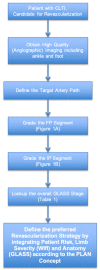The Global Limb Anatomic Staging System (GLASS) for CLTI: Improving Inter-Observer Agreement
- PMID: 34441757
- PMCID: PMC8396876
- DOI: 10.3390/jcm10163454
The Global Limb Anatomic Staging System (GLASS) for CLTI: Improving Inter-Observer Agreement
Abstract
Objective: The 2020 Global Vascular Guidelines aim at improving decision making in Chronic Limb-Threatening Ischemia (CLTI) by providing a framework for evidence-based revascularization. Herein, the Global Limb Anatomic Staging System (GLASS) serves to estimate the chance of success and patency of arterial pathway revascularization based on the extent and distribution of the atherosclerotic lesions. We report the preliminary feasibility results and observer variability of the GLASS. GLASS is a part of the new global guideline and posed as a promising additional tool for EBR strategies to predict the success of lower extremity arterial revascularization. This study reports on the consistency of GLASS scoring to maximize inter-observer agreement and facilitate its application.
Methods: GLASS separately scores the femoropopliteal (FP) and infrapopliteal (IP) segment based on stenosis severity, lesion length and the extent of calcification within the target artery pathway (TAP). In our stepwise approach, we used two angiographic datasets. Each following step was based on the lessons learned from the previous step. The primary outcome was inter-observer agreement measured as Cohen's Kappa, scored by two (step 1 + 2) and four (step 3) blinded and experienced observers, respectively. Steps 1 (n = 139) and 2 (n = 50) were executed within a dataset of a Dutch interventional RCT in CLTI. Step 3 (n = 100) was performed in randomly selected all-comer CLTI patients from two vascular centers in the United States.
Results: In step 1, kappa values were 0.346 (FP) and 0.180 (IP). In step 2, applied in the same dataset, the use of other experienced observers and a provided TAP, resulted in similar low kappa values 0.406 (FP) and 0.089 (IP). Subsequently, in step 3, the formation of an altered stepwise approach using component scoring, such as separate scoring of calcification and adding a ruler to the images resulted in kappa values increasing to 0.796 (FP) and 0.730 (IP).
Conclusion: This retrospective GLASS validation study revealed low inter-observer agreement for unconditioned scoring. A stepwise component scoring provides acceptable agreement and a solid base for further prospective validation studies to investigate how GLASS relates to treatment outcomes.
Keywords: CLTI; GLASS; critical ischemia; observer agreement.
Conflict of interest statement
The authors declare no conflict of interest.
Figures
References
-
- Fowkes F.G.R., Rudan D., Rudan I., Aboyans V., Denenberg J.O., McDermott M.M., Norman P.E., Sampson U.K.A., Williams L.J., Mensah G.A., et al. Comparison of global estimates of prevalence and risk factors for peripheral artery disease in 2000 and 2010: A systematic review and analysis. Lancet. 2013;382:1329–1340. doi: 10.1016/S0140-6736(13)61249-0. - DOI - PubMed
LinkOut - more resources
Full Text Sources
Miscellaneous



